I have a red coris wrasse in my saltwater tank and they are very elegant and amazing animals. I must say are not beginner-friendly fish. They are a bit hard to keep. But with the correct guidance, you can not only care for them but also breed them.
Red Coris Wrasse is a vibrant-colored marine fish from the Indo-Pacific. It is a quite large fish that needs a spacious aquarium. Also known as Clown Wrasse, Red Labrid, or Yellowtail Coris, this fish changes its colors when it grows up. Let’s learn A to Z about Red Coris Wrasse in this care guide.
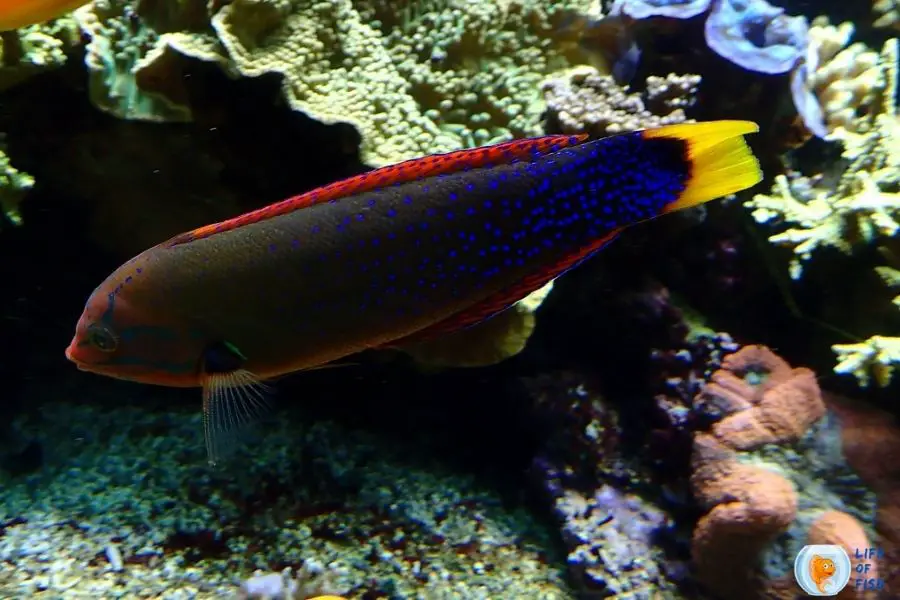
One look Care guide
Jump To
- 1 One look Care guide
- 2 What is red Coris Wrasse?
- 3 How big do red Coris Wrasse get?
- 4 Red Coris Wrasse Appearance and Markings
- 5 Is red Coris Wrasse aggressive?
- 6 Red Coris Wrasse behavior
- 7 Lifespan
- 8 Red Coris Wrasse care
- 9 Red Coris Wrasse breeding
- 10 How to feed red Coris Wrasse?
- 11 What fish can live with red Coris Wrasse?
- 12 Related questions
| Scientific name | Coris gaimard |
| Common name | Red Coris Wrasse, Clown Wrasse, Red Labrid, Yellowtail Coris, Gaimard’s Wrasse |
| Care level | Moderate to Difficult |
| Native to | Indo-Pacific ocean, Hawaiian Region, and the Red Sea |
| Type | Marine Fish |
| Family | Labridae |
| Color | Blueish body, Yellow, red and blue fins, orange face with green stripes |
| Tank size | 125 gallons |
| Preferred temperature | 22 to 26 C (72 – 79 F) |
| Other water parameters | Ph level: 8.1 to 8.4 Specific gravity (salinity) : 1.020-1.025 Hardness: dKH 8-12 |
| Preferred salinity | sg 1.020-1.025 |
| Size of the red Coris Wrasse | 14- 16 inches in the wild, 6- 8 inches in captivity |
| Life Span | 5 Years with Proper Care |
| Temperament | Semi- Aggressive |
| Recommended tank mates | Similar sized and large fish Blennies, Butterflies, Boxfish, Clownfish, Hawk fish, Rabbitfish, Angelfish |
| Preferred food | Carnivore, Mollusks, and other invertebrates |
| Feeding frequency | 2 to 3 times per day |
| Breeding | Egg layers, Nest builders, utilize prenatal Care |
Learn about the different types of wrasse fish and their natural habitats in our comprehensive guide!” – wrasse fish
What is red Coris Wrasse?
They are saltwater fish that lives along coral reefs in the Indo-Pacific ocean, Hawaiian Region, and the Red Sea. They belong to the family Labridae. The adult fish is multicolored and has the ability to change its spots. They lives under sand substrate most of the time. It is a quite large fish that grows up to 14 inches long.
How big do red Coris Wrasse get?
They can easily reach 14 to 16 inches in the wild. But, in an aquarium, they hardly reach 6 to 8 inches in length. However, this is apparently a large fish species that need significant space to grow. Therefore, their growth gets stunted when captivated.
Red Coris Wrasse Appearance and Markings
Juveniles and adults have distinct appearances. These fish start their life as red color fish with black-rimmed white spots around their back region. As they grow up, their colors and markings change dramatically.
The adult fish body is usually blue in color. The fins have shades in blue, yellow and red, and the face is orange with green stripes. Adult fish has a bright yellow tail. Colorwise, there is a difference between males and females too. Male fish are more grayish, and they have a green bar behind the gill. Females are usually dark blue and have a red color fringe.
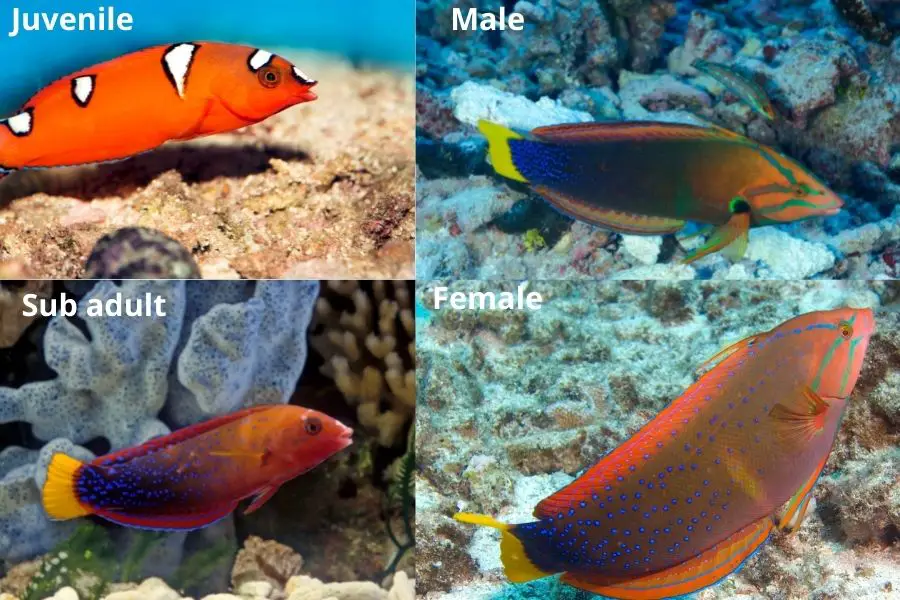
Is red Coris Wrasse aggressive?
They are semi-aggressive fish species. They are not aggressive as a juvenile but become destructive when they grow up. You can not keep invertebrates with them as they feed on invertebrates. They can be aggressive towards their own species and other small fish species. However, they aren’t particularly aggressive toward other similar-sized and large fish species.
Red Coris Wrasse behavior
They are carnivore fish that eats mollusks, and other small invertebrates live on the reef. Therefore, they are not “reef safe” fish to keep with. Usually, these fish turn over rocks and corals to find food. So, they can damage your coral reef if you keep this fish in your reef aquarium.
These fish bury themselves in the sand substrate to sleep at night and for protection when harassed or frightened. They prefer bright lights and have a tendency to jump often. Therefore, it is wise to keep a tight cover in your aquarium. Red Coris Wrasses are nest builders that lay their eggs in nests. As it is difficult to recreate their breeding environments, breeding them in captivity is unusual.
Lifespan
They have an average life span of five years in captivity.
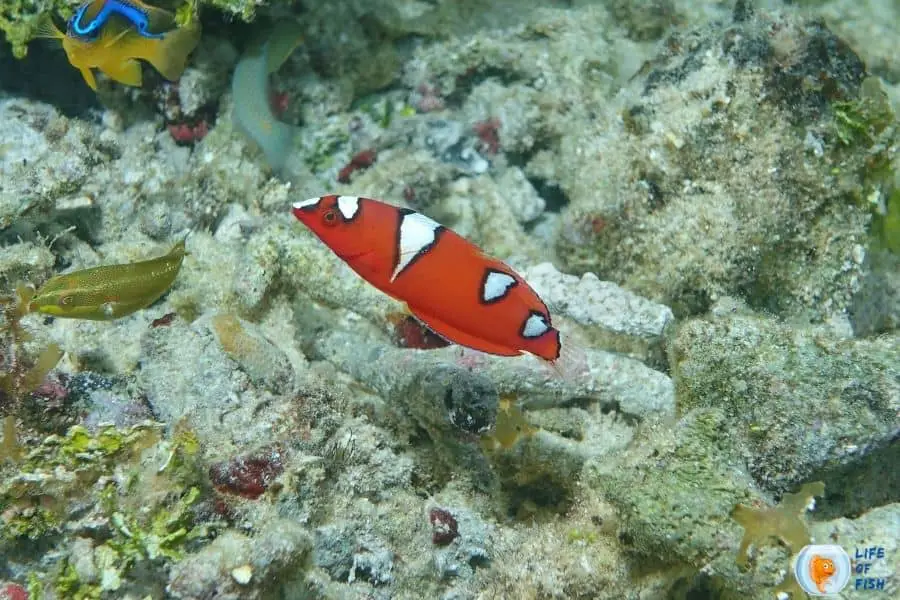
Red Coris Wrasse care
They are not a regular type of fish that is kept in aquariums. It needs intermediate-level experience to care for them. And also, they tend to have poor life expectancy in captivity. So, it is advised to keep these marine fish in their natural habitats rather than keeping them in the aquarium. But, if you are an experienced aquarist, you can safely keep this fish in your aquarium with proper Care.
Size
In the wild, they grow for about 14 to 16 inches. But in aquariums, they reach only 6 to 8 inches in length. This is due to stunted growth because of insufficient space.
Tank size
It is a relatively large fish that needs a spacious aquarium. The minimum recommended tank size is 125 gallons. But, if you can provide a giant aquarium, it is better.
How many Wrasse should be kept together?
They often get aggressive towards their own species. So, it is wise to keep just one Wrasse in an aquarium. However, you can keep a mated pair together in an aquarium.
Tank setup
As it is a large fish, you need to set up a larger tank of 125 gallons at the least. Also, it is a very active fish species. So, they need plenty of space to swim freely. You have to fill it up with saltwater. They are not reef-safe species because they tend to turn over corals and rocks in search of food.
So, if you can, avoid adding coral reefs and rock to the aquarium. The substrate should be a soft sand bed of at least 4 inches deep as they prefer burying themselves in the sand when threatened and at night. They prefer brightly lit aquariums as they like bright lights. You should cover the aquarium with a top cover because these species tend to jump high.
Water quality condition
As they are marine fish, they need saltwater in aquariums in order to survive. The water temperature should be 22 to 26 C (72 – 79 F), and the pH level should be around 8.1 to 8.4. The specific gravity (salinity) of water should be at sg 1.020-1.025, and the preferred water hardness level is dKH 8-12.
In order to keep ammonia, nitrite, and nitrate levels low, you should install a proper filtration system in your aquarium. Additionally, you should perform a 20-30% water change weekly to remove any excess fish waste.
Male or female identification
There are distinct differences between male and female fish. Juvenile fish of both sexes have the same trait of red color body with black-rimmed white “saddles.” When they turn into adults, the colors change significantly. Males become dark grey with a green bar behind the gill. On the other hand, females become dark blue with a red fringe.
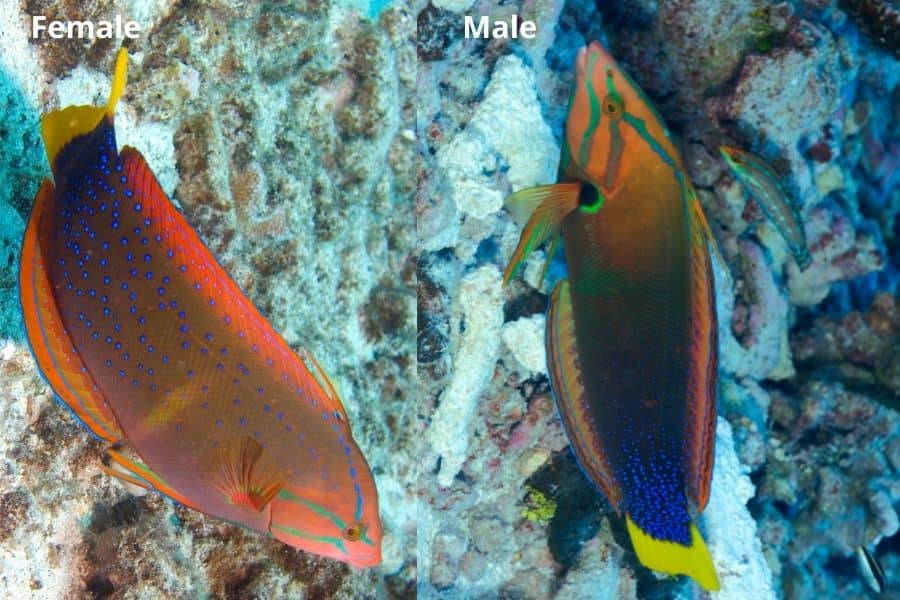
Red Coris Wrasse breeding
Like other fish in the Labridae family, they also utilize the most complex and unusual reproduction systems known to fish. Males build nests in specific environments to collect the eggs, and Females lay eggs in these nests, leaving the eggs in male Care. Male Wrasse shows prenatal Care and protects the eggs from predators until the fry can survive themselves. As this fish needs specific environmental conditions to breed, it is almost impossible to reproduce them in aquariums.
Identify pregnant fish
Pregnancy is highly unlikely in captivity as they are nest builders that need specific habitats to build nests. Red Coris Wrasses are egg layers that lay their eggs in nests. It is challenging to recreate their optimal breeding environmental conditions in captivity. So, you may never see a pregnant fish in aquariums.
How many babies does red Coris Wrasse have?
There are no known records of their egg quantity per spawn, but fish in the Labridae family usually lays about 1000 eggs at a time.
Fry care
They have Prenatal Care. Male Wrasses protect their eggs in the nests until the fry can survive for themselves.
Special tips
It is unusual to breed them in aquariums. Most of them sold in the market are wild-caught ones. Most tiny juveniles do not fare well in captivity. They usually starve to death due to the lack of accepting food. So, it is recommended to buy a subadult juvenile at least two inches long that is already eating well to avoid problems with starvation.
While the species are generally hardy, they are prone to internal bacterial infections associated with the bladder because of the poor substrate conditions in an aquarium. You should avoid crushed coral or any similar substrate in the aquarium as this fish buries itself in the substrate, and crushed coral may harm them. If you wish to keep any shrimps, crabs, mollusks, or other invertebrates in your aquarium, it is not a good choice as they eat invertebrates.
How to feed red Coris Wrasse?
They are carnivore species that feed on mollusks and other small invertebrates in the wild. They need a vitamin-enriched meat diet to thrive in an aquarium. You can feed them with small-sized food such as blackworms, Mysis shrimp, brine shrimp, fresh and frozen seafood, and grass shrimp.
Make sure they are vitamin enriched as they need a high-calorie diet filled with vitamins. You can also feed them with high-quality fish flakes and pellets. Red Coris Wrasse needs about two to three meals per day, and you should feed them in small quantities as they can not digest a large amount of food in one feeding. For smaller Wrasses, be sure to chop the food before feeding them finely. Juvenile red Coris Wrasses have enormous appetites. So, you should feed them more meals than adults.
What fish can live with red Coris Wrasse?
They are semi-aggressive fish species that lives well with similar-sized fish and large fishes. They do not get along with their own species unless it is a mated pair. So, you shouldn’t keep more than one Wrasse in one aquarium. Some compatible fish species for them are,
- Blennies
- Butterflies
- Boxfish
- Clownfish
- Hawkfish
- Rabbitfish
- Angelfish
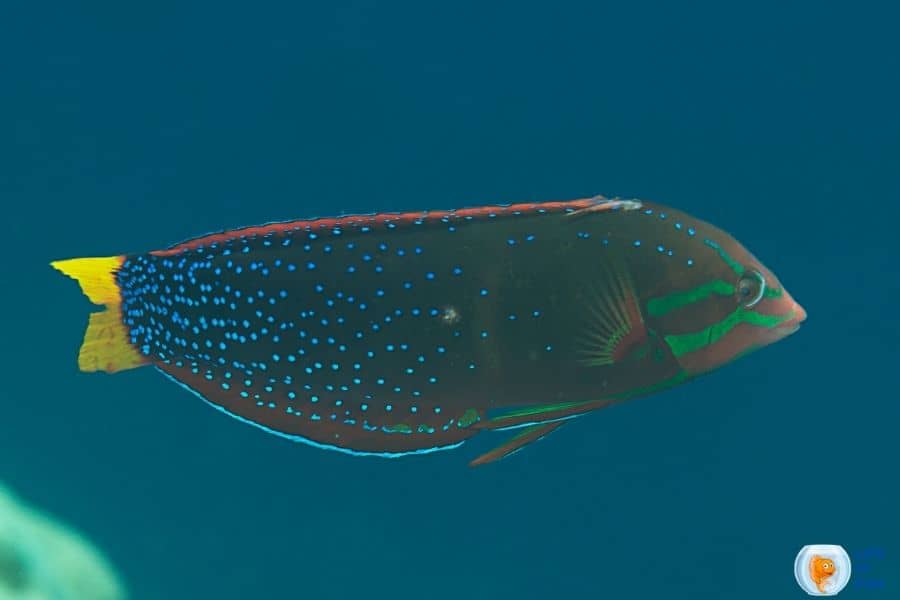
Related questions
Is the Red Coris Wrasse reef safe?
No. they are not considered “reef-safe.” As juveniles, these fish are peaceful and do not harm any other fish or corals. But, when they grow up, they become destructive. Adult red Coris Wrasses often move the rockwork and damage the corals in the aquarium in search of food. Therefore, they are not “reef-safe” fish.
Is Red Coris Wrasse good?
They are one of the most beautiful fishes in the world. Keeping them in your aquarium will definitely give a magnificent look to your aquarium. However, these fish are known to have a poor life expectancy when kept in captivity. Therefore, it is not good to keep them in captivity (unless you are an expert aquarist).
What does Red Coris Wrasse eat?
They eat mollusks, small fishes, and other small invertebrates in the wild. In captivity, they eat flakes, pellets, blackworms, Mysis shrimp, brine shrimp, fresh and frozen seafood, and grass shrimp. For juvenile fish, you can also feed copepods. Red Coris Wrasse is a carnivore fish species that need vitamin-rich meat-based food.
Is Wrasse reef safe?
Wrasse is not “reef safe” because they tend to move rocks and corals to search invertebrates. They prefer eating invertebrates. So, you will find them moving rocks often. Because of this, the corals can get damaged. Therefore, Wrasse is not reef safe.
Read Next: Bird Wrasse | Learn About Hardy And Bird-Like Marine Fish | Carpenter’s Flasher Wrasse | Unique And Amazing Fish |
